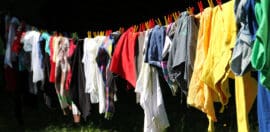A good box and a good conversation

The Good Box co-founders from right to left: Gali Blacher and Madelyn Jones. Credit: Daniella Photography
1 May 2019 at 8:24 am
Do you know what to do when you see a person sleeping rough? The Good Box is aiming to be a simple answer to the question most of us have asked ourselves, and to change the conversation around homelessness, writes Maggie Coggan in this month’s Spotlight on Social Enterprise.
Walking to work each day, co-founder of The Good Box Gali Blacher made sure to say hello to the people she saw sleeping rough.
She also knew that she was one of the few people who bothered to stop during their morning commute.
“I would just see people walk past, ignoring these people like they weren’t even there. There was even one time I saw a person just step over a person sleeping rough like they were a rock,” she recalls.
After hearing a number of different stories from people she talked to each day, she realised how multifaceted the issue of homelessness actually was.
“One person I spoke to had a degree, and a family, and previously had a big-time job. Things just didn’t work out and unfortunately it was a domino effect and he found himself on the streets,” Blacher tells Pro Bono News.
“It just made me realise that homelessness can happen to anyone.”
She also started to question why most people preferred to not stop and talk to those sleeping rough.
“Most said while they wanted to give money to rough sleepers, they thought it would go to drugs or alcohol… so they didn’t do anything,” Blacher said.
She joined forces with her now co-founder Madelyn Jones. They knew they weren’t going to solve the issue of homelessness, but they could try and make a difference to the issue in front of them.
“On the one hand, you’ve got people sleeping rough who are experiencing isolation, and on the other hand you’ve got people who are wanting to give but they don’t because they think it’s going to go to drugs or alcohol,” Blacher says.

Jones and Blacher with Damo, a consultant from the homelessness working group. Credit: Daniella Photography
They set up meetings with people experiencing homelessness via the City of Sydney to discuss what would make a difference, not only for the homeless community but the general public too.
“I decided to speak with the homeless community and create boxes with things they wanted and needed in them. People could then buy these boxes to give directly to people experiencing homelessness,” Blacher says.
There are three boxes available for purchase; one for men, women and a unisex box.
They are filled with useful items such as a face towel, condoms, a muesli bar, tampons and pads, baby wipes and deodorant. The “unisex” box also contains a surprise gift, which could be anything from a movie ticket to a voucher for a hair cut.
“People might think because you’re homeless, you shouldn’t be able to do anything fun like going to the movies or luxurious like a haircut,” Blacher says.
“But what we don’t realise is that those little things help build confidence because if you aren’t feeling good about yourself, everything is going to stay static.”
The decision as to what went in the boxes was heavily influenced by the homeless working group.
“They told me to stick away from unhealthy food, and that they already get too many toothbrushes,” she says.
“They also really loved the fact this was a beautifully packaged box with only the best quality of things, nothing second hand.
“Getting a beautifully packaged gift really does make them feel better. Obviously, it’s amazing when people do give them second-hand things, but it’s different.”
One of the biggest lessons Blacher learned from the consultations was how important a good conversation was to people experiencing homelessness.
“I was often told a conversation was sometimes as important as a meal because they could find a meal, but if no one wants to talk to them it’s hard not to feel like a second rate citizen,” she says.
Now that people have started buying the boxes, Blacher has discovered the impact of that conversation can go both ways via feedback from customers.
“A woman who purchased a box messaged us and told us about the great conversation she had with the person she gave the box to on her way to work,” Blacher says.
“She also told us that she was shocked when the man that received the box told her he’d been sitting there for two months and only two people constantly talk to him. But hopefully, something like The Good Box can change that.”
Each box also tells the real-life story of a person experiencing homelessness, and where you can find them on a little map, through illustrations drawn on all sides of the product.
This was a priority of the homeless working group, who felt it was an important part of communicating to customers that each of their stories was different, and how they became homeless was not as clear cut as the average person might think.
Blacher explains that if people were going to buy the product, she and Jones wanted them to learn something that would get them thinking and talking about the issue.
“We wanted the people buying our product to be learning something. We didn’t think people would want to read an essay, but they might be engaged by images,” she says.
There is also space on the bottom of the box for the giver to write a note for the person receiving the box. Blacher says this act has had a profound impact on some.
“A woman who received a box via one of our charity partners actually burst into tears when she read the note because she was so overwhelmed at the fact that someone had taken the time and effort to leave her a written note,” she says.
To support the work already being done in the homelessness support space, the enterprise partnered with Orange Sky Laundry, Jewish House and Share the Dignity, three charities providing support for various aspects of homelessness.
Blacher said this was also important in order to reach the vast majority of people experiencing homelessness who aren’t as visible.
“There would be a lot of people left out if we were just giving the boxes to people sleeping rough,” she says.
With the recent launch of The Good Box’ online store, buyers have the option of receiving the box directly or sending it onto one of the three charity partners.
Blacher believes this has been one of the ways the organisation has been able to assist its charity partners the most.
“Charities often have to get volunteers in to create little goodie bags for when people come and stay in their short-term accommodation,” she says.
“So it saves them quite a lot of money because we send them the box and they don’t have to worry about it.”
As The Good Box only launched in February this year, Blacher and Jones are still finding their feet in the social enterprise world.
While the enterprise has pledged to give 35 per cent of all profits to their charity partners, Blacher admits they haven’t made enough money yet to donate money.
But she predicts with the increase in sales thanks to the online store, they will break a profit by the end of the financial year.
They have big plans for the future, which include partnering with more charities to increase their reach and educating the public about the complexities of homelessness.
“We’ve already done a couple of sessions with schools and corporates where they pack the boxes, and we then give them an education session about homelessness, and we are definitely aiming to do more,” she says.
“We want to help people become more comfortable with giving a box directly to someone experiencing homelessness and really help to break down the barrier between those who are and aren’t homeless, something that can only be achieved through educating people.”








This is a brilliant idea!!!!!
Congratulations! How could I help in some way local to me?